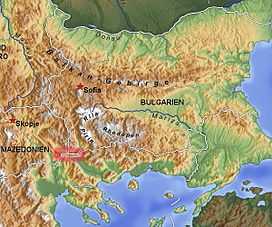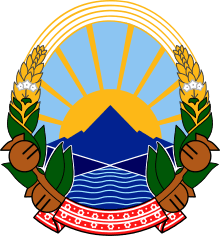Belasica
- This article is about the mountain range. For the football teams, see PFC Belasitsa Petrich and FK Belasica.
| Belasica | |
|---|---|
|
The linear ridge of Belasica, with Lake Dojran on the left | |
| Highest point | |
| Peak | Radomir Peak |
| Elevation | 2,029 m (6,657 ft) |
| Naming | |
| Native name | Bulgarian and Macedonian: Беласица - Greek: Μπέλλες or Κερκίνη |
| Geography | |
|
<div style="padding:2px 2px 5px 2px;>  Location of Belasica (circled in red) | |
| Countries | Bulgaria, Greece and Republic of Macedonia |
| Range coordinates | 41°20′N 22°57′E / 41.33°N 22.95°ECoordinates: 41°20′N 22°57′E / 41.33°N 22.95°E |
Belasica or Kerkini or Belles (Macedonian and Bulgarian: ![]() Беласица , also transliterated as Belasitsa or Belasitza; Greek: Μπέλλες, Bélles, or Κερκίνη, Kerkíni) is a mountain range in the region of Macedonia in Southeastern Europe, shared by northwestern Greece (about 45%), southeastern Republic of Macedonia (35%) and southwestern Bulgaria (20%).
Беласица , also transliterated as Belasitsa or Belasitza; Greek: Μπέλλες, Bélles, or Κερκίνη, Kerkíni) is a mountain range in the region of Macedonia in Southeastern Europe, shared by northwestern Greece (about 45%), southeastern Republic of Macedonia (35%) and southwestern Bulgaria (20%).
Geography
The mountain range is about 60 km (37.28 mi) long and 7 to 9 km (4.35 to 5.59 mi) wide and is situated just northeast of Dojran Lake. The highest point is Radomir (Kalabak) at 2,029 m, with elevation otherwise ranging between 300 and 1900 m above sea level. The borders of all three countries meet at Tumba Peak. The climate in the area shows strong Mediterranean influence.
The area of Belasica became a euroregion in 2003. Two football teams are named after the mountain range, PFC Belasitsa from the nearby Bulgarian town of Petrich and FC Belasica from Strumica in the Republic of Macedonia.
History
During the Antiquity its name was Órbēlos (Ὄρβηλος).[1] According to the ancient authors it was a mountain range in the border area between Thrace and Macedonia.[2] It is generally equated today with the modern Belasica.[3] The name Órbēlos is probably derived from the ancient Thracian/Paionian toponym of the mountain, which means shining mountain, from 'belos' - blazing or shining and 'or' - mountain.[4] It was known for its Dionysos cult. [5]
The area is also particularly famous for the Battle of Kleidion of 1014, which proved crucial for the fall of the First Bulgarian Empire.
Honour
Kongur Glacier on Smith Island, South Shetland Islands is named after the peak and nature reserve of Kongur on Belasitsa Mountain.
Photo Gallery
-
Smolare Falls on Belasica in Republic of Macedonia
See also
References
- Belasitsa. Tourist map, Sofia, 2006.
- Благоевъ, Т. А. Бѣласица. София, 1925.
- Динчев, Евг., Атанасов, П. Високите планини на Република Македония. Пътеводител, София, 1998, стр. 214-224.
- "Енциклопедия Пирински край". Том 1, Благоевград, 1995, стр. 78.
References
- ↑ The Cambridge Ancient History: The Assyrian and Babylonian Empires and Other States of the Near East, from the Eighth to the Sixth Centuries B.C., Nicholas Geoffrey, Lemprière Hammond, Cambridge University Press, 1995, ISBN 0521227178, p. 594.
- ↑ (Hdt. 5,16; Str. 7a,1,36; Arr. Anab. 1,1,5)
- ↑ Brill Online Reference Works - Orbelus von Bredow, Iris (Bietigheim-Bissingen).
- ↑ Beiträge zur Namenforschung, C. Winter., 1995, S. 241-242.
- ↑ T. Spiridonov, Istoričeskata geografija na trakijskite plemena, 1983, 24 f., 118.
External links
| Wikimedia Commons has media related to Belasitsa. |
| |||||||||||||||||||||||||||||||||||||||||
| |||||||||||||||||||||||||||||||||||||||||||||||||||||||||||



